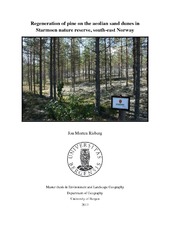Regeneration of pine on the aeolian sand dunes in Starmoen nature reserve, south-east Norway
Master thesis
Permanent lenke
https://hdl.handle.net/1956/6935Utgivelsesdato
2013-05-15Metadata
Vis full innførselSamlinger
- Department of Geography [634]
Sammendrag
This study aims to elucidate ecological processes and human interaction concerning regeneration of pines (Pinus sylvestris and Pinus mugo ssp uncinata) 36 years after a fire in Starmoen nature reserve (1976). The reserve has an underlying substrate of aeolian sand dunes, which create a unique landscape with a varying topographic relief. This results in a difference in exposure to solar radiation among the different topographic units, which again affects growth conditions of the different types of vegetation through for example moisture. Sampling of data was done under a stratified approach with 8 transects of 8 plots each. Within these plots, measurements were made of relative radiation index, number of recruits, DBH structure, degree of canopy cover and cover of ground vegetation. Soil samples were taken to estimate moisture and loss-on-ignition. Several analyses were done with the compiled data, including correlation, t-tests, regression, multiple regression and analysis of spatial autocorrelation. The size of adult trees varied greatly, depending on which topographic unit they were located on, and its specific growth conditions. Regeneration was mostly successful for the native Pinus sylvestris, whereas the introduced pine, Pinus mugo ssp. uncinata had little to no on-going reproduction. The inferential statistics indicated that difference in exposure to solar radiation (expressed as radiation index) across the sand dunes had an effect on the %-moisture in the soil, which also affects distribution of lichens and ericaceous dwarf shrubs. Regeneration of Scots pine was interpreted to be strongly inhibited by lichens as well as ericaceous dwarf shrubs (mainly heather) when one life-form dominated the ground vegetation. However, a mosaic of both life forms gave the optimal conditions for Pinus sylvestris seedlings. The study questioned the decision to introduce an alien pine species for reforestation, and shows that future sustainability would be better with the native Scots pine.
